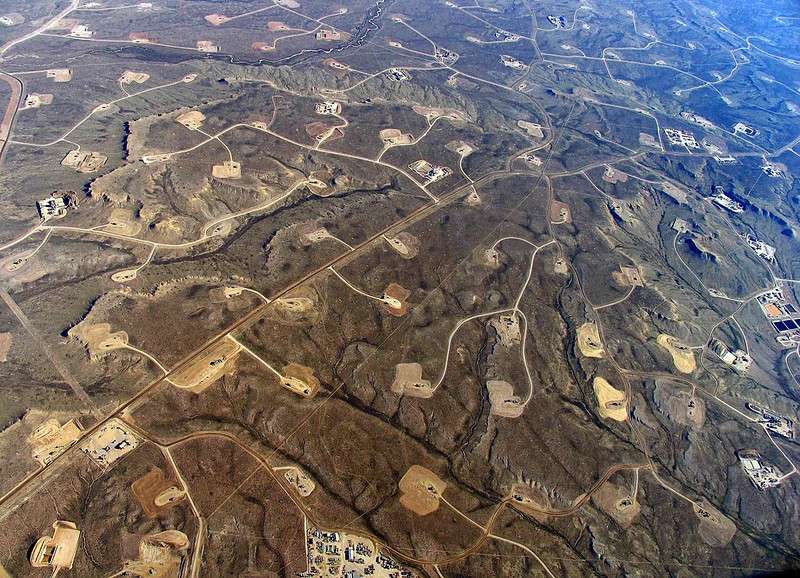- About
- Topics
- Picks
- Audio
- Story
- In-Depth
- Opinion
- News
- Donate
-
Signup for our newsletterOur Editors' Best Picks.Send
Read, Debate: Engage.
| January 15, 2020 | |
|---|---|
| topic: | Fracking |
| tags: | #Fracking, #energy, #fossil fuel |
| by: | Ama Lorenz |
It is often employed in the oil industry for exploratory missions but its primary use is the extraction of identifiable deposits of natural shale gas or oil. However, fracking has quickly become a controversial procedure due to concerns about its toxic impact on the environment and health.
Once geologists have identified an area that contains deposits such as shale gas, a bore hole is drilled vertically into the earth to a depth of around one mile. The bore hole passes through the upper layers of the earth's crust, the water table and various subterranean layers until it reaches the shale.
As the most commonly found sedimentary rock, charcoal-coloured shale consists primarily of mud compressed together with various particles of calcite and quartz. Shale has a structure consisting of horizontal layers with minute channels between that are prone to fissility or splitting in a similar manner to slate. Fracking or hydraulic fracturing exploits shale's natural composition to encourage gas trapped between its layers to escape.
When the well has reached the shale layer, drill rods are used to create multiple horizontal shafts. These generally extend to approximately eight hundred metres but they can sometimes be several kilometres in length.
The next stage involves vast quantities of liquid being forced under extreme pressure to enter the shafts. The ever-increasing volume of fracking liquid forces its way into the minute fissures in the shale until the rock shatters. Sand, ceramic beads and chemicals known as proppants are then channelled along the shafts to help keep the fissures open as the gas or oil is forced to the surface.
The explosive characteristics of fracking effectively release gas that is embedded between the layers of shale. However, the shale gas that works its way to the surface consists primarily of methane. The greater part of it is collected but an estimated four percent escapes into the atmosphere.
Methane is considered to be up to twenty-five times more harmful to the ozone layer than carbon emissions due to its effectiveness at confining heat. Consequently, environmentalists are alarmed at the detrimental effect fracking has on global warming. Other escaping gases include carbon monoxide, benzene, formaldehyde and nitrogen oxides.
Chemicals are added to the liquid at a rate of between 0.5 and 2.0% to perform various functions. Some are proppants such as sintered bauxite and zirconium oxide which help to keep the fissures open. Peroxodisulfate regulate the viscosity of the liquid and bactericides are added to prevent the gas becoming contaminated.
Stabilisers such as potassium chloride and sodium carbonate control the acidity of the liquid. Hydrochloric acid is used to clean the drilling equipment while methanol and ammonium bisulfate prevent it corroding. Uranium, mercury and lead are also known to be present.
The fracking procedure uses literally millions of gallons of water to fracture the shale deposits. It is estimated that up to 40% of the waste water laden with the chemicals mentioned above, inevitably returns to the surrounding area's ground water supply. Major causes of concern are the safety of drinking water and the irrigation of agricultural land which could lead to contaminated crops.
The Environmental Protection Agency of America where hydraulic fracturing is widespread, recently confirmed that chemicals linked to fracking had been found in the local drinking water reserves where the procedure was taking place. Many of the chemicals used in fracking can have an adverse effect on health.
Cancer, impairment of the endocrine system and degenerative neurological diseases are just some of the side effects from continued exposure to many of the fracking chemicals.
There is currently much debate over the responsibility of fracking in causing earthquakes. The issue is further confused by many fracking sites being located in areas such as California where there is regular seismic activity.
Each year the UK has an estimated fifteen minor earth tremors with low magnitudes. However, in 2011 two earthquakes occurred just 500 metres away from a fracking site in the north west of England.
Experts concluded that the fierce pressure of the fracking liquid aggravated a minute fault of approximately 100 metres. This caused it to move by less than one centimetre to produce a minor tremor of 2.3 on the Richter Scale.
Like so many inventions, the origin of fracking lies in warfare. In 1862, during the American Civil War, Colonel Edward Roberts was so impressed by the effectiveness of firing explosives along underground channels at the Battle of Fredericksburg that he patented the procedure. It provided the theory for fracking but sporadic experimentation in America didn't occur until after WWII.
By the late 1970s the procedure had drastically increased the recovery of crude oil. In the subsequent decades, fracking proved to be a relatively inexpensive process, reducing the cost of natural gas and oil. With such economic advantages and the world's insatiable need for fuel, it's easy to understand how the temptation to use fracking has become so widespread particularly in America, Canada, China and Poland.
Fracking hasn't been in use long enough to assess some of the long-term hazards but there is enough evidence to prompt countries such as Germany and the American states of Maryland and New York to enforce a ban. Everyone wants the benefit of cheap fuel but perhaps the risks involved in fracking are too high a price to pay.
By copying the embed code below, you agree to adhere to our republishing guidelines.
